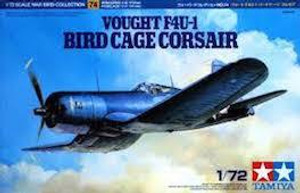
Tamiya #61046 F4U-1 Bird Cage Corsair Chance Vought
Easily the finest Corsair kit that's ever been produced. Flaps are fixed down, canopy can be open or closed. Can be built as standard –1 version, or radar-equipped –2. Two choices of canopy types. Includes bombs and drop tanks.
This plastic kitset requires assembly, paints and glue to complete.
Wingspan: 9–1/4" (23.6cm)
Fuselage Length: 8" (20.5cm)
Designed around the new Pratt & Whitney R-2800 2,000HP radial engine, and turning the largest propeller ever attached to a fighter plane, the Chance Vought F4U Corsair became a legend in its own time. First flown in May 1940, this gull winged wonder was deemed a winner from the outset. The Navy was so confident in the Corsair that rival companies Brewster and Goodyear were made alternate contractors for the initial order of 584 aircraft. With a top speed of 415mph and a rate of climb of 3,120 feet per minute, the Corsair was the fastest plane in the world at the time. Unacceptable aircraft carrier landing performance however, caused the F4U-1 to become a land-based fighter with the U.S. Marine Corps at the beginning of its career.
In November 1941, the U.S. Navy requested Vought to produce a radar-equipped version of the F4U-1; however, they were too occupied with production to accomplish the request. The task was turned over to the Naval Aircraft Factory which produced 32 of the 34 F4U-2 Corsairs made. Obvious changes were adding a radar dome to the outboard .50 caliber machine gun to offset the radar domes weight, plus flame dampeners installed on the six exhaust stacks. These F4U-2 night fighting Corsairs became the pioneers in developing the technology that led to U.S. night fighting tactics employed throughout WWII.